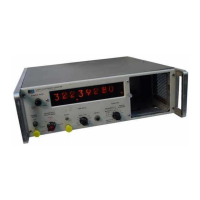Model
5245L
lighted,
the lamp
associated
with
the noncon-
ducting
transistor
is
dark.
Typically, volt-
ages
will
be
as
shown.
Since
the transistor
associated
with
the dark
lamp
is not
conduct-
ing,
no
current is
flowing
in the
circuit
of the
dark
lamp, and
voltage
across
it
is
established
(a)
by
the
circuit
of the
conducting
lamp and
its transistor,
and
(b)
by
the voltage
on
the
collector
of the
non-conducting
transistor.
This
voltage is not
high
enough
to fire
the dark
lamp.
(2)
When
the
binary shown
in Figure 2-8A changes
state,
the
voltage
on the
collector of transistor
A
(now
conducting)
drops
to
-10
volts,
while
the
voltage
on
the
collector
of
nonconducting
transistor
A rises
to
+19 volts. Withtransis-
tor
A
turned off,
current through lamp
A
de-
creases, and
the
voltage at the
junction
of the
two
lamps
rises.
Since Iamp A
cannot
fire
until
ionized,
voltage will
continue to rise until the
?0-volt
firing
level is
reached; the
junction
will
reach
approximately
?3 volts
during
the ioni-
zation
period.
After the
dark
lamp
fires, the
voltage across
it
stabilizes at
about 55 volts,
and
since the
voltage
across the
other lamp
is
now
reduced
to
38 volts, the
other
lamp
extinguishes.
(3)
Circuit
state
after
lamp
A
has fired
is
shown
in
Figure 2-8A-2;
it
is
the
mirror image
of
that
shown
in Figure 2-8A-1.
b.
Lamp
Circuit with
Diodes.
The
steady,
or
stora
it is indicated
in
Figure
2-88-1.
The diodes
are
forward-biased,
eff
ectively
connecting the
lamps
in
parallel
and
clamp-
ing them
to approximately
-1.5
volts.
One
lamp
is
conducting,
the other
lamp
is
dark.
Since
both lamps
are
clamped to
-1.5
volts,
regardless
of
the
state of
the
binary, there
will
never
be sufficient
voltage across
the
dark
tight
to
fire
it and
it
wiII
remain dark until
1) the
diodes are reverse-biased
and
2)
there
is
con-
duction through
the
transistor
in whose
collector cir-
cuit
the lamp
is
connected.
(1)
When
the
gate
closes at the
completion
of
the
counting
period (see
Paragraph
2-95)
a
-29
volt
transfer
pulse (see
Paragraph
2-99)
is
applied
to
the
binary diodes,
reverse-biasing
them.
With the
diodes
reverse-biased,
the
lamps
are
disconnected
from
each other,
and
the
circuit for
each lamp
is now
completed
through
its
associated
transistor.
(2)
If the
state of the
binary is
the same
as
that
at
the
end
of the
previous
counting
period,
the
lamps
'(see',
the voltages
required to
maintain
them
without
change.
If,
however,
the
digit
is
such
that the
binary state is
changed,
the
lamps
change
state.
With
the
diodes
reverse-biased,
circuit action
is
the
same
as that
described
in subparagraph a.
Condition
of the
circuit during the
initiat
period
of the
transfer
pulse
when voltage
across the
dark
lamp
is increasing is indi-
cated in
Figure
2-BB-2;
circuit
condition
after
the
lamp
has fired
is indicated
in
Fig-
ure
2-BB-3.
02349-
1
Section
II
Paragraphs 2-36
to 2-40
c.
Disabling the
Storage.
Whenthefunctionselector
is set to
MANUAL or
theSTORAGE
switchon
the
rear
panel
is in the off
position,
the
storage feature
is
disabled.
Circuit
action is then
described in
sub-
paragraph
a.
2-36. BAStC COUNTER FUNCTtONS.
2-37,
GENERAL.
a.
The
basic counter circuits
are
arranged
to
pro-
vide several functional modes of
operation. Each
arrangement
includes
a main
AND
gate
with 1) a
signal
input and 2) a
control
input, or
gating
signal.
Following
the maingate
is a
cascaded
series of
decimal
counters
which
accumulate and display the
total
num-
ber
of
pulses
which
pass
through
the main
gate.
The
various modes
of
operation
are
discussed in Para-
graphs
2-36
through
2-41.
b. Circuit sequence
in
the various
modes of opera-
tion
is
similar:
pulses
pass
through the
main
gate
to
the decimal
counters
for a
predetermined
time, are
counted
and displayed.
The difference
between
ar-
rangements is in 1)
the
source
of
the
pulses
counted,
and 2) the
source of thegatingsignalwhich
establishes
the
length of time during which
the main
gate
is
open
to
pass
pulses
to the decimal
counters.
2-38. TOTALIZING.
In
the totalizing mode
(see
Figure
2-9A),
the
gate
flip-flop is
controlled
by
the
FUNCTION switch
when it is in the
MANUAL
START
or
MANUAL
STOP
positions.
The
decimal
counters
count
the total
number of input
pulses
applied while
the main
gate
is
held
open with the
FUNCTION switch
in the MANUAL
START
position.
SwitchingtheFUNC-
TION switch
to
the
MANUAL STOP
position
closes
the
main
gate
and the number
of
pulses
which
came
through
the main
gate
while it was
open
are
displayed.
2-39.
FREQUENCY
MEASUREMENT.
The circuit
arrangement
shown
in Figure 2-9B
permits
control of
the
main
gate
by the
counter
time base. The
gate
is
opened
for
a controlled
time, therefore
the accumu-
Iated
count
represents
the
number of input
cycles or
pulses
during
this time. Controlled intervals
are
from 10
seconds
down
to 1 microsecond in
decade
sub-
multiples,
selectable
with
the front
panel
TIME
BASE
switch.
The decimal
point
is
automatically
positioned
and
the
readout is
in
kilohertz
or megahertz
with the
units
in
line
with the
digital
display.
2-40.
PERIOD
MEASUREMENT.
The
arangement
shown
in Figure
2-9C
provides
the
meansformeas-
uring
the
period
of
the
input
signal.
The
period
of
a
signal
is
the time required for
the completion of
one
cyclel the counter displays
the time
in
seconds,
milli-
seconds
or microseconds.
The
period
measurement
is obtained
by making the duration of
tfie
gating
signal
equal to
the
period
of the input
signal,
and
counting
a
train
of
pulses
supplied bythe
counter
time base. The
displayed
count is
the
number of
time-base
pulses
which
occur
during one
period
of
the
input
signal.
For
multiple
period
measurements,
Figure
2-9D, the
input
signal
is divided bythe
selected
decadefactor
so
that the
gating
signal
is
the
selected
multiple of one
2-g

